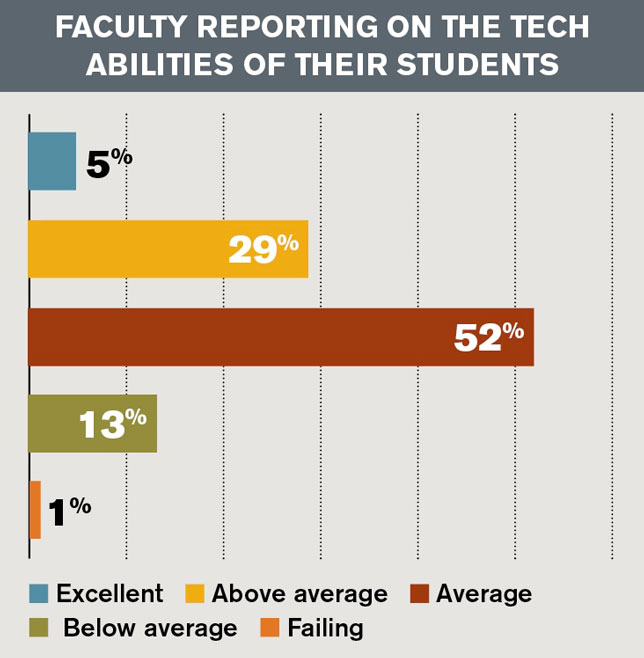Survey: Faculty Confident in Their Own Tech Skills, but Say Student Skills Lag
In our latest Teaching with Technology Survey, most faculty said they are comfortable using tech in the classroom, but many reported low-to-average tech skills among their students.
Nearly all faculty in a recent survey believe they have adequate skills (or better) to get the job done when it comes to teaching with technology. And a full 77 percent said they are "absolutely confident" or "very confident" with tech use.
These findings come out of Campus Technology's 2018 Teaching with Technology Survey, which asked higher education faculty at colleges and universities across the country about their use of tech in the classroom, students' tech skills, the availability of tech support and more.
While most survey respondents feel comfortable with technology, a small portion (just 2 percent) still lack confidence, calling their tech skills "below average." Respondents' estimation of students' tech abilities, however, is significantly worse: Fourteen percent of respondents called their students "below average" or "failing" in the technology department. About half of faculty said their students had average tech skills, and only a third judged their students' tech skills "above average" or "excellent."

"Several of my freshmen students come to campus with few technology skills," shared one faculty member at a four-year public institution in Indiana. "I am not sure where they are missing getting these skills, but they know very little about the tools built into word processors or how to research apps for proper use with students. They need more exposure to the tools in word processors that allow them to collect research, properly cite references in multiple formats, and work with graphics in a word processor. Those basic skills translate to other applications and are necessary for college work."
Another faculty member at a four-year private nonprofit institution in Florida agreed: "Digital literacies need to be defined and planned for! Our students vastly overestimate their abilities."
We also asked faculty where they turn when they need technology help. Sixty-two percent of respondents said they have access to adequate support and training for their tech use. About one-third — 34 percent — prefer to do an online search to solve tech problems that come up. Twenty-four percent seek help from the IT department, while 16 percent turn to an instructional technologist. And 15 percent get tech help from peers.
Some of our survey respondents expressed frustration with the proliferation of technology in education — and the time required for training and support. "Administrators need to realize the purpose of technology in education is to make things easier on everyone and facilitate student learning," said one faculty member at a four-year private nonprofit institution in Indiana. "There is still too much time spent on making it all 'work.'"
"So many possibilities, and so little help for teachers to use them — teachers and faculty just don't have time to learn and do all the tech on their own," added a faculty member at a four-year public institution in Georgia. "It is ever expanding!"
Still, there was also a sense of optimism: "I have had the honor of working with faculty as they work to gain ed tech skills and as they transform their curricula to meet today's blended learning requirements," said a faculty member at a four-year public institution in Nebraska. "Today's educators are a resilient bunch, and will be good leaders for the next generation. I have worked also with upcoming students and residents, and have every confidence that the next generation will do just fine integrating ed tech in their excellent education offerings."
Note: We will post more results from the survey over the coming weeks. You can check back for ongoing coverage in our Research section.
About the Author
Rhea Kelly is editor in chief for Campus Technology, THE Journal, and Spaces4Learning. She can be reached at [email protected].